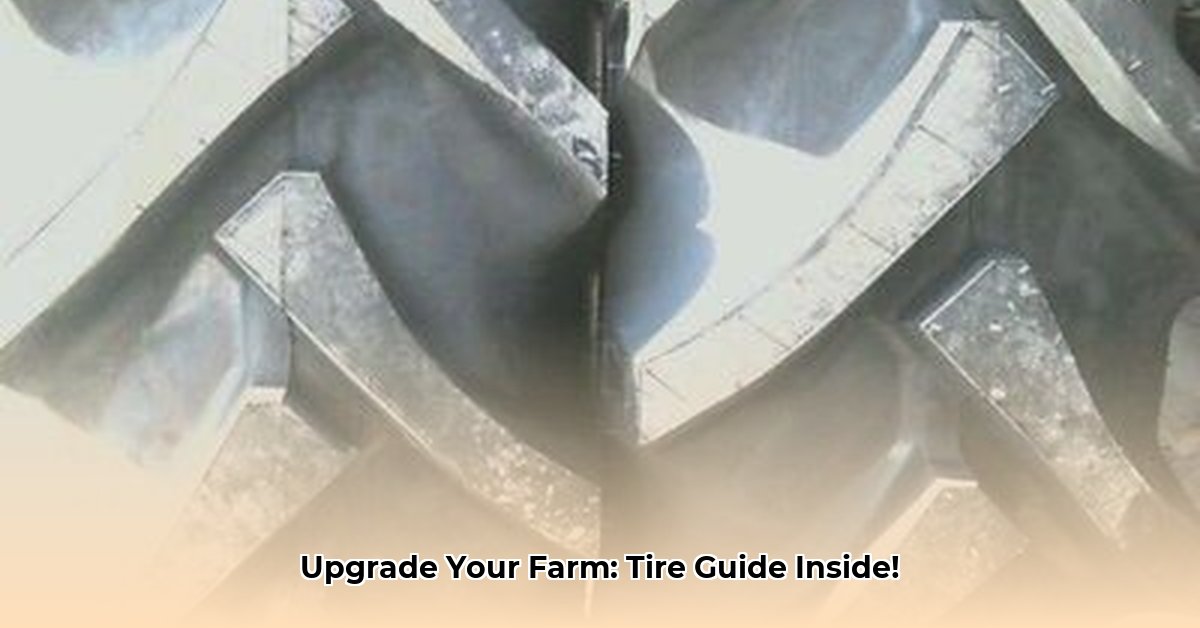
Choosing the right tractor tires is crucial for farm efficiency, soil health, and profitability. This guide focuses on the common 12.4 x 24 size, helping you select tires that balance cost, performance, and sustainability. For more tire options, check out this helpful resource: Cub Cadet tires.
Factors to Consider When Choosing a 12.4 x 24 Tractor Tire
Several key factors influence your tire selection. Let's examine each one:
Budget: Balancing Initial Cost and Long-Term Value
12.4 x 24 tractor tires vary significantly in price. While cheaper options initially seem attractive, higher-quality tires often offer superior durability, resulting in lower long-term costs. Consider the total cost of ownership, factoring in potential premature wear and tear. A more expensive tire that lasts longer might actually save you money in the end. Do the math – the initial cost difference might be offset by reduced replacement costs over the tire's lifecycle.
Workload: Matching Tire Specifications to Your Needs
Your tractor's workload directly impacts tire selection. Heavy hauling requires tires with high load capacity and ply rating (indicating tire strength), whereas lighter tasks may allow for less robust options. Mismatched tires can lead to premature wear and potential equipment damage. Understanding your typical workload and matching it to the tire's specifications is crucial to selecting the right tire for optimal performance.
Traction: Optimizing Grip for Various Soil Conditions
Tire tread pattern and rubber compound significantly affect traction. Aggressive treads provide superior grip in mud and challenging conditions, while smoother treads are better suited for paved surfaces. Unfortunately, comprehensive data comparing different tread patterns and rubber compounds for 12.4 x 24 tires isn't readily available. Consult with your tire supplier for advice tailored to your specific soil conditions. Choosing the wrong tread can significantly impact your efficiency and productivity.
Fuel Efficiency/Rolling Resistance: Minimizing Fuel Costs and Environmental Impact
Rolling resistance, the force resisting tire movement, directly impacts fuel consumption. Lower rolling resistance translates to better fuel efficiency, saving you money and minimizing your environmental impact. However, detailed rolling resistance data for specific 12.4 x 24 tires is often scarce. Check manufacturer specifications whenever possible; even small improvements in rolling resistance can add up to significant cost savings over time. This consideration is especially important in light of rising fuel costs and the need for sustainable agricultural practices.
Tire Lifespan: Maximizing the Return on Investment
Several factors influence tire lifespan, including proper inflation, regular maintenance, and appropriate workload. Higher-quality tires typically offer extended lifespan, lowering the long-term cost of ownership. Consider the total cost of ownership, factoring in the price of the tire and the cost of replacement, to make an informed decision. Investing in a durable tire can lead to significant savings over multiple seasons.
Sustainability: Choosing Environmentally Responsible Options
Consider the environmental impact of tire manufacturing, use, and disposal. Look for manufacturers employing sustainable materials and offering tire recycling programs. While detailed eco-friendly comparisons are challenging, selecting a durable tire that lasts longer inherently reduces the environmental cost of frequent replacements and contributes to a more sustainable farming practice. Prioritizing longer-lasting tires reduces waste and contributes to a smaller environmental footprint.
Tire Selection Process: A Step-by-Step Guide
- Assess Your Needs: Determine your budget, workload, typical soil conditions, and fuel efficiency goals.
- Research Options: Explore manufacturer websites (e.g., https://www.tires-easy.com/tires/c/farm/12.4--24) and consult with agricultural equipment dealers. Pay close attention to load capacity, ply rating, and tread pattern information.
- Compare Available Data: While detailed performance data may be limited, compare tires based on load index and ply rating, focusing on these key specifications.
- Seek Expert Advice: Consult experienced farmers or agricultural professionals for insights based on real-world experience.
Maintenance and Best Practices: Prolonging Tire Life and Optimizing Performance
- Regular Inspections: Regularly check tire pressure and look for cuts, bulges, or other signs of damage.
- Proper Inflation: Maintain correct inflation pressure as recommended by the manufacturer. Underinflation increases wear and fuel consumption; overinflation can damage the tire.
- Rotation: Rotate tires periodically for even wear distribution.
- Storage: Store tires properly to protect them from damage.
Resources and Further Reading
Consult your local agricultural extension service and reputable farm equipment dealers for additional information and expert advice.
By carefully evaluating these factors and following this guide, you can select a 12.4 x 24 tractor tire that optimizes your farm's efficiency, minimizes environmental impact, and maximizes your return on investment. Remember that choosing the right tire is a crucial investment in the long-term success of your operation.